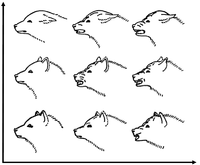Dog behavior

Dogs are furry friends who have their own way of communicating and expressing their emotions. Just like humans, dogs have feelings and different behaviors. Let's explore some of the common dog behaviors:
1. Tail wagging: This is one of the most common dog behaviors and usually means that the dog is happy or excited. If the tail is wagging slowly and relaxed, it can indicate that the dog is feeling calm or content. However, if the tail is wagging quickly and tightly, it can signal that the dog is feeling nervous or aggressive.
2. Barking: Dogs bark to communicate various emotions like excitement, fear, or aggression. If a dog barks continuously, it can be a sign that they need attention or are trying to warn their owner of possible danger.
3. Licking: Dogs often show affection by licking humans or other animals. However, they also lick themselves to keep clean or show nervousness.
4. Body language: Dogs often use their body posture to express different emotions like fear or aggression. For example, if a dog raises its hackles or stands tall, it can mean that they are feeling aggressive. In contrast, if a dog puts its tail between its legs, drops its head, and crouches down, it can indicate that the dog is scared.
5. Chewing: Dogs love to chew on objects like toys, bones, and sticks. This behavior is a way for them to relieve boredom, stress, or to keep their teeth clean.
6. Digging: Dogs dig holes in the ground to hide their possessions like bones or toys. They also dig holes to escape the heat or to create a shelter.
7. Jumping: Dogs jump to show their excitement or to greet people they like. However, it's important to train dogs not to jump on people, as it can be dangerous and scary for some individuals.
Understanding dog behavior is essential for dog owners to communicate with their pets effectively. By learning their body language and behaviors, you can build a closer bond with your furry friend and ensure their needs are met.
1. Tail wagging: This is one of the most common dog behaviors and usually means that the dog is happy or excited. If the tail is wagging slowly and relaxed, it can indicate that the dog is feeling calm or content. However, if the tail is wagging quickly and tightly, it can signal that the dog is feeling nervous or aggressive.
2. Barking: Dogs bark to communicate various emotions like excitement, fear, or aggression. If a dog barks continuously, it can be a sign that they need attention or are trying to warn their owner of possible danger.
3. Licking: Dogs often show affection by licking humans or other animals. However, they also lick themselves to keep clean or show nervousness.
4. Body language: Dogs often use their body posture to express different emotions like fear or aggression. For example, if a dog raises its hackles or stands tall, it can mean that they are feeling aggressive. In contrast, if a dog puts its tail between its legs, drops its head, and crouches down, it can indicate that the dog is scared.
5. Chewing: Dogs love to chew on objects like toys, bones, and sticks. This behavior is a way for them to relieve boredom, stress, or to keep their teeth clean.
6. Digging: Dogs dig holes in the ground to hide their possessions like bones or toys. They also dig holes to escape the heat or to create a shelter.
7. Jumping: Dogs jump to show their excitement or to greet people they like. However, it's important to train dogs not to jump on people, as it can be dangerous and scary for some individuals.
Understanding dog behavior is essential for dog owners to communicate with their pets effectively. By learning their body language and behaviors, you can build a closer bond with your furry friend and ensure their needs are met.
Related topics others have asked about:
